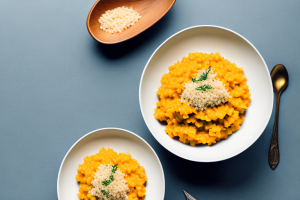How to steam basmati rice with saffron
7 min read
A pot of steaming basmati rice with saffron threads
If you’re looking for an elegant and flavorful side dish to accompany your next meal, consider steaming basmati rice with saffron. This dish is not only delicious, but also very nutritious, thanks to the combination of long-grain rice and saffron, a spice known to have many health benefits. In this article, we’ll walk you through every step of the process, from measuring the ingredients to serving the rice on a plate. So grab your apron and let’s get started!
The nutritional benefits of basmati rice and saffron
Before we dive into the specifics of cooking basmati rice with saffron, let’s take a moment to talk about the nutritional benefits of these two ingredients. Basmati rice is a long-grain rice that’s often used in Indian and Middle Eastern dishes. It’s low in calories, fat-free, and a good source of carbohydrates and fiber. Saffron, on the other hand, is a spice made from the stigma of the saffron crocus flower. It’s rich in antioxidants and is believed to have anti-inflammatory properties. Together, these ingredients make a nutritious and delicious dish that’s perfect for any occasion.
Additionally, basmati rice is also a good source of vitamins and minerals such as thiamin, niacin, and vitamin B6. These vitamins are essential for maintaining a healthy nervous system, promoting healthy skin, and aiding in the metabolism of carbohydrates. Saffron, on the other hand, contains several important minerals such as copper, potassium, and magnesium. These minerals are important for maintaining healthy blood pressure, promoting healthy bones, and aiding in the production of red blood cells. By incorporating basmati rice and saffron into your diet, you can reap the many nutritional benefits that these ingredients have to offer.
Equipment needed for steaming basmati rice with saffron
Before you start cooking, make sure you have all the necessary equipment. You’ll need a large pot with a lid, a fine-mesh strainer, a small bowl, a measuring cup, and a wooden spoon. If you have a rice cooker, you can use that instead of a pot.
Additionally, you may want to have a mortar and pestle on hand to crush the saffron threads before adding them to the rice. This will help release their flavor and aroma. It’s also a good idea to have a timer or clock nearby to keep track of the cooking time and ensure that the rice is cooked to perfection.
How to properly measure basmati rice and saffron
The first step to making saffron-infused basmati rice is to measure out the ingredients. For every cup of rice, you’ll need two cups of water or chicken broth. If you’re using saffron, you’ll need about 1/4 teaspoon for every cup of rice. To measure the saffron, crumble the threads into a small bowl and add a tablespoon of hot water. Let the saffron soak for at least 10 minutes before using it. This will help release its flavor and color.
It’s important to note that the quality of the basmati rice and saffron can greatly affect the final dish. Look for high-quality, long-grain basmati rice and saffron threads that are deep red in color. Lower quality ingredients may result in a less flavorful and visually appealing dish. Additionally, be sure to rinse the rice thoroughly before cooking to remove excess starch and prevent clumping.
The importance of soaking basmati rice before steaming with saffron
One crucial step to making perfect saffron-infused basmati rice is to soak the rice before cooking it. Soaking helps remove excess starch and makes the rice more fluffy and less sticky. To soak the rice, rinse it with cold water and let it sit in a bowl for at least 30 minutes, or up to 2 hours.
Another benefit of soaking basmati rice is that it can help reduce cooking time. When you soak the rice, it absorbs water and becomes more tender, which means it will cook faster and more evenly. This can be especially helpful if you’re in a hurry or if you’re cooking for a large group of people.
It’s also important to note that soaking basmati rice can help improve its nutritional value. Soaking can help break down the phytic acid in the rice, which can make it easier for your body to absorb important nutrients like iron and zinc. This means that soaking your rice can not only make it taste better, but it can also make it healthier for you.
Step-by-step guide to steam basmati rice with saffron
Now that you have all the ingredients measured and the rice soaked, it’s time to start cooking. Here’s a step-by-step guide:
- Fill a large pot with water and bring it to a boil over high heat.
- Drain the rice and add it to the pot.
- Add the saffron water and salt to taste. Stir gently.
- Cover the pot with a lid and reduce the heat to low.
- Let the rice simmer for about 15-20 minutes, or until all the liquid has been absorbed.
- Turn off the heat and let the rice sit for 5-10 minutes, still covered. This will help the rice absorb any remaining moisture and fluff up even more.
- Fluff the rice with a wooden spoon and serve hot.
Basmati rice is a long-grain rice that is commonly used in Indian and Middle Eastern cuisine. It has a delicate flavor and aroma, and when cooked properly, it has a light and fluffy texture. Saffron is a spice that is often used in these cuisines as well, and it adds a unique flavor and color to the rice.
When cooking basmati rice with saffron, it’s important to use the right ratio of rice to water. Typically, you’ll want to use about 1.5 cups of water for every cup of rice. However, if you’re using saffron, you’ll want to use slightly less water, as the saffron water will add some moisture to the rice. Aim for about 1.25 cups of water per cup of rice when using saffron.
Tips to enhance the flavor and aroma of your saffron-infused basmati rice
If you want to take your saffron-infused basmati rice to the next level, here are a few tips to enhance its flavor and aroma:
- Toast some slivered almonds or cashews in a dry pan and sprinkle them over the rice before serving.
- Chop up some fresh cilantro or parsley and mix it into the rice for added color and brightness.
- Drizzle some clarified butter or ghee over the rice for a richer flavor.
Another way to enhance the flavor of your saffron-infused basmati rice is to add some whole spices to the cooking water. You can add a cinnamon stick, a few cardamom pods, and a couple of cloves to the water before adding the rice. This will infuse the rice with a subtle, warm flavor that complements the saffron perfectly.
Serving suggestions for your perfectly cooked saffron basmati rice
Saffron-infused basmati rice is a versatile side dish that pairs well with many main dishes, such as grilled or roasted meats, curries, and stews. You can also serve it as part of a rice bowl with vegetables and a protein source. Whatever you choose, be sure to serve the rice hot and fluffy.
If you want to add some extra flavor to your saffron basmati rice, you can mix in some toasted nuts, such as almonds or cashews, or some dried fruits, like raisins or cranberries. This will give your rice a sweet and nutty taste that complements the saffron well.
Another way to serve saffron basmati rice is to stuff it into vegetables, such as bell peppers or tomatoes, and bake them in the oven. This makes for a beautiful and delicious vegetarian main dish that is sure to impress your guests.
How to store leftover saffron basmati rice for later use
If you have leftover saffron basmati rice, you can store it in an airtight container in the fridge for up to four days. To reheat, add a little water or chicken broth to the rice and microwave it until warmed through.
It’s important to note that reheating rice multiple times can increase the risk of food poisoning. If you have reheated the rice once and still have leftovers, it’s best to discard them instead of reheating again.
If you want to freeze the leftover saffron basmati rice, transfer it to a freezer-safe container and store it in the freezer for up to three months. To reheat, thaw the rice in the fridge overnight and then microwave it with a little water or chicken broth until warmed through.
Variations on traditional saffron-infused basmati rice recipes
If you want to experiment with different flavors and textures, here are a few variations on traditional saffron-infused basmati rice recipes:
- Add some raisins or chopped dried apricots to the rice for a slightly sweet flavor.
- Mix in some cooked peas or diced carrots for added color and nutrition.
- Replace the water or broth with coconut milk for a creamier texture.
With these tips and variations, you should be able to master the art of cooking saffron-infused basmati rice in no time. Enjoy your delicious and nutritious creation!
Another variation you can try is adding some toasted almonds or cashews to the rice for a crunchy texture and nutty flavor. Simply toast the nuts in a dry pan until they are lightly browned and fragrant, then sprinkle them over the cooked rice before serving.
If you want to make your saffron-infused basmati rice even more flavorful, you can add some spices such as cumin, coriander, or cardamom to the rice while it cooks. These spices will complement the saffron and add depth to the dish.


